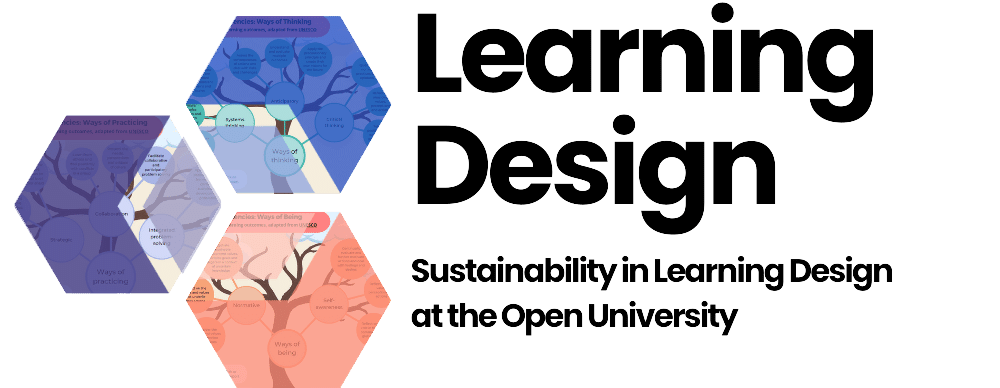Being curious is an important part of the journey towards embedding sustainability. It can be difficult trying to untangle what sustainability means in a design context and how to make that meaningful for students. The Open University’s Learning Design Team has created a set of resources to help prompt initial thoughts and discussions about embedding sustainability in course design. The aim is to prompt educators to reflect on whether sustainability can be included in the course design, and to flag that support is available.
Sustainable development
- meets the needs of the present without compromising the ability of future generations to meet their own needs
- works towards building an inclusive, sustainable and resilient future for people and the planet
- harmonises the three core elements of environmental protection, social inclusion and economic growth. These elements are interconnected and all are crucial for the well-being of individuals, societies and economies.
The United Nations Sustainable Development Goals
The Sustainable Development Goals (SDGs) were adopted by the United Nations in 2015 as a call for action by all countries to mobilise to end all forms of poverty, fight inequalities and tackle climate change, ensuring no-one is left behind.
The 17 UN SDGs address all three core elements of sustainable development and help to show the breadth of sustainability topics.
A first step in thinking about embedding sustainability
It is likely that your first step will be reflection on what sustainability might mean to you in your context. For example,
- Do you want to ensure that sustainable skills and competencies are woven into the student journey?
- Are you looking for practical ways to connect learning outcomes to sustainable skills development?
- Do you want to use student voice to help drive and inform sustainability-focused content design?
- Are you looking for existing sustainability resources to reuse (such as those available on OpenLearn)?
- Are you looking for information about what the HE sector is doing more broadly?
The infographic 'Sustainability principles thinking' contains a short series of awareness-raising prompts. Where to begin? helps you consider the wider scope through which impact can be made: learning outcomes, student voice, reuse of existing resources, and the role of Higher Education.
Sustainability competencies in learning design
The United Nations Educational, Scientific and Cultural Organization (UNESCO) states that, for people to understand the complex world in which we live, we need to be able to collaborate, speak up, and act for positive change as 'sustainability citizens'. UNESCO has identified eight key sustainability competencies that allow us to engage constructively and responsibly, which include knowledge, capacities, and motivation.
The sustainability competencies are interrelated and key to achieving the SDGs. These are:
- Systems thinking: The ability to recognise and understand relationships; to analyse complex systems; to think of how systems are embedded within different domains and different scales; and to deal with uncertainty.
- Anticipatory: The ability to understand and evaluate multiple scenarios for the future – possible, probable and desirable; to create one’s own visions for the future; to apply the precautionary principle; to assess the consequences of actions; and to deal with risks and changes.
- Normative: The ability to understand and reflect on the norms and values that underlie one’s actions; and to negotiate sustainability values, principles, goals, and targets, in a context of conflicts of interests and trade-offs, uncertain knowledge and contradictions.
- Strategic: The ability to collectively develop and implement innovative actions that further sustainability at the local level and further afield.
- Collaboration: The ability to learn from others; to understand and respect the needs, perspectives and actions of others (empathy); to understand, relate to and be sensitive to others (empathic leadership); to deal with conflicts in a group; and to facilitate collaborative and participatory problem-solving.
- Critical thinking: The ability to question norms, practices and opinions; to reflect on one’s own values, perceptions and actions; and to take a position in the sustainability discourse.
- Self-awareness: The ability to reflect on one’s own role in the local community and (global) society; to continually evaluate and further motivate one’s actions; and to deal with one’s feelings and desires.
- Integrated problem-solving: The overarching ability to apply different problem-solving frameworks to complex sustainability problems and develop viable, inclusive and equitable solution options that promote sustainable development, integrating the above-mentioned competences.
We have created a set of infographics to help visualise each of the eight sustainability competencies in our context.
These infographics show the relationship between the competencies and the cognitive, socio-emotional and behavioural learning domains that can be used in the development of learning objectives.
Sustainability skills and student voice
We included students in the co-design of a set of sustainability skills design cards by inviting student input through our Curriculum Design Student Panel. The skills cards develop the eight UNESCO sustainability competencies with adaptation in some terminology to meet OU student and colleague needs. They help to visualise what it might look like to use the eight UNESCO sustainability competencies in practice when designing a course.
The cards take the language we used in our competency tree visualisations and turn it into actionable ways to connect with sustainability. They also take the language of UNESCO and connect it with existing OU frameworks (employability, digital information literacy (DIL), and activity type taxonomy) to support the development of learning outcomes and/or activity design.
How you can use the skills cards
You could use these skills cards:
- To identify practical ways to make learning outcomes connect to sustainable skills development.
- To help you consider how you may want certain sustainability skills and competencies to be woven into the student journey.
- To consider how to embed sustainability skills within your own subject context




Rate and Review
Rate this article
Review this article
Log into OpenLearn to leave reviews and join in the conversation.
Article reviews